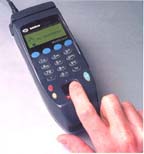 Using fingerprints for ID, K-12 food service operators are speeding lunch lines, simplifying payment and improving reimbursement for programs linked to school lunch. Students simply place a forefinger on a small reader by the register. Public schools such as those in the Penn Cambria and Wilson School Districts in Pennsylvania have adopted this technology to speed operation; simplify payment; limit lunch fraud and bullying; improve National School Lunch Program (NSLP) participation; and to improve reimbursement for programs such as Title I, E-rate, and No Child Left Behind, which use NSLP food service data to gauge poverty.
Using fingerprints for ID, K-12 food service operators are speeding lunch lines, simplifying payment and improving reimbursement for programs linked to school lunch. Students simply place a forefinger on a small reader by the register. Public schools such as those in the Penn Cambria and Wilson School Districts in Pennsylvania have adopted this technology to speed operation; simplify payment; limit lunch fraud and bullying; improve National School Lunch Program (NSLP) participation; and to improve reimbursement for programs such as Title I, E-rate, and No Child Left Behind, which use NSLP food service data to gauge poverty.
“Unlike cash, tickets and swipe cards which can be lost or stolen, your fingers are always with you – and no one can use them to gain fraudulent access to your account,” says Brenda Bucynski, secretary to Penn Cambria School District’s Foodservice Director.
Allaying fears of identity theft, Mitch Johns, president of Food Service Solutions, the company that implemented the biometric use of fingerprints in the Penn Cambria School District as well as scores of schools and colleges throughout the U.S., is quick to point out that his system does not store any prints.
“Only the numbers are retained in the form of a mathematical algorithm and those cannot be reinterpreted into a fingerprint image,” explains Johns. “Both parents and students can rest assured that the images cannot be used by law enforcement for identification purposes.”
“Biometrics technology has brought much needed anonymity to our foodservice program,” says Dr. Russell Strange, Superintendent of Penn Cambria School District. “Not even the cashiers know which students are ‘free’ or ‘reduced,’ and the students and parents have responded well.”
“For ten years prior to the system, high school averaged 28.6% low income,” continues Strange. “Now in our fourth year of using the biometric system, high school’s low income is 42.7%, with a four-year average of 39.1%. High school is only 2% points below elementary low income for 2004-2005. The additional reimbursement enables us to provide higher quality meals and more generous servings.”
“Teachers love that the new system gets lunch money out of their classrooms,” says Bucynski. “One teacher says she’s gained half-an-hour of teaching time a day, since she no longer has to concern herself with lunch money during class.”
The Wilson School District in West Lawn, Penn. turned to this biometric ID technology primarily to expedite the lunch payment processing at the request of parents.
“Parents didn’t want to dole out $1.60 for their child every day, or give them a $10.00 bill and wonder if they’d ever see the change,” says Pat Anthony, Foodservice Director for the Wilson School District. “Parents wanted to pre-pay for lunch, but keeping track of accounts with paper and pencil was untenable. And we didn’t want to buy into a system where parents would end up taping PIN numbers to their kid’s hands.”




